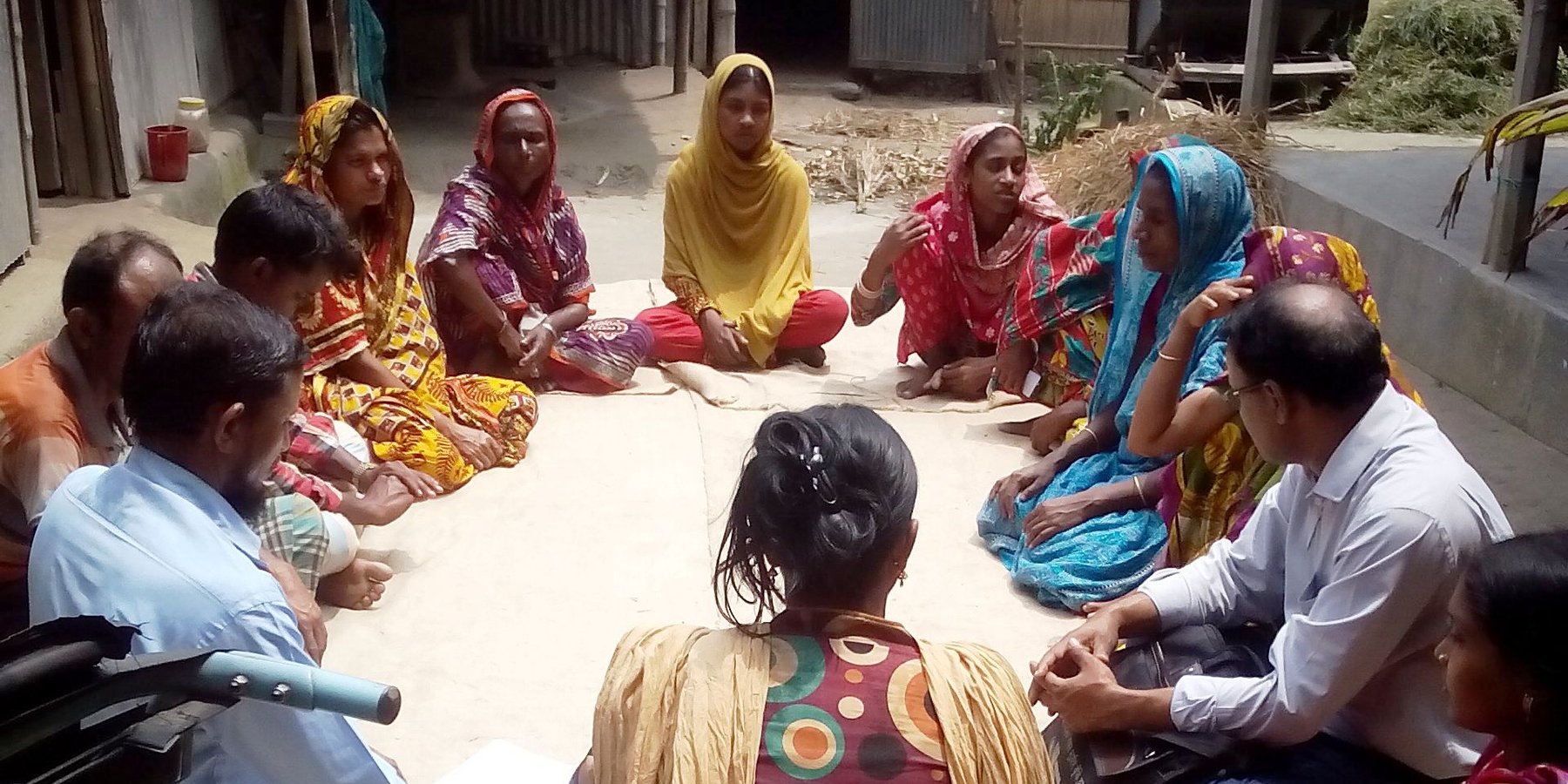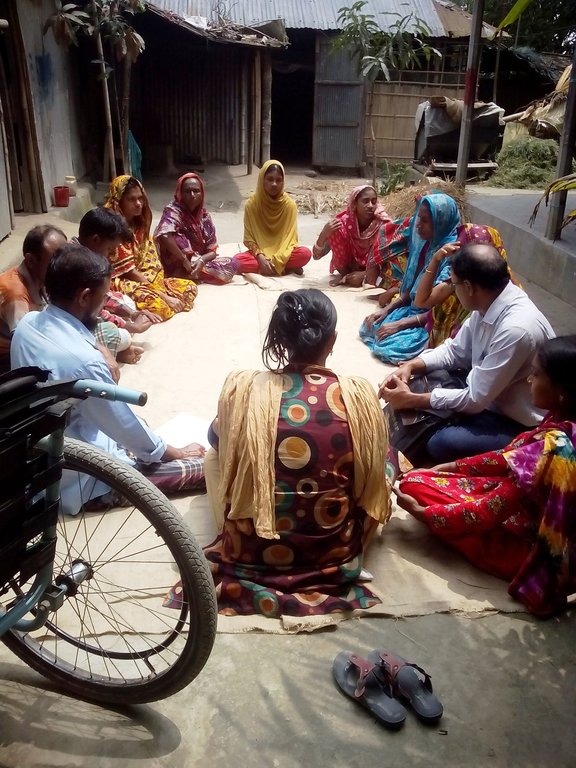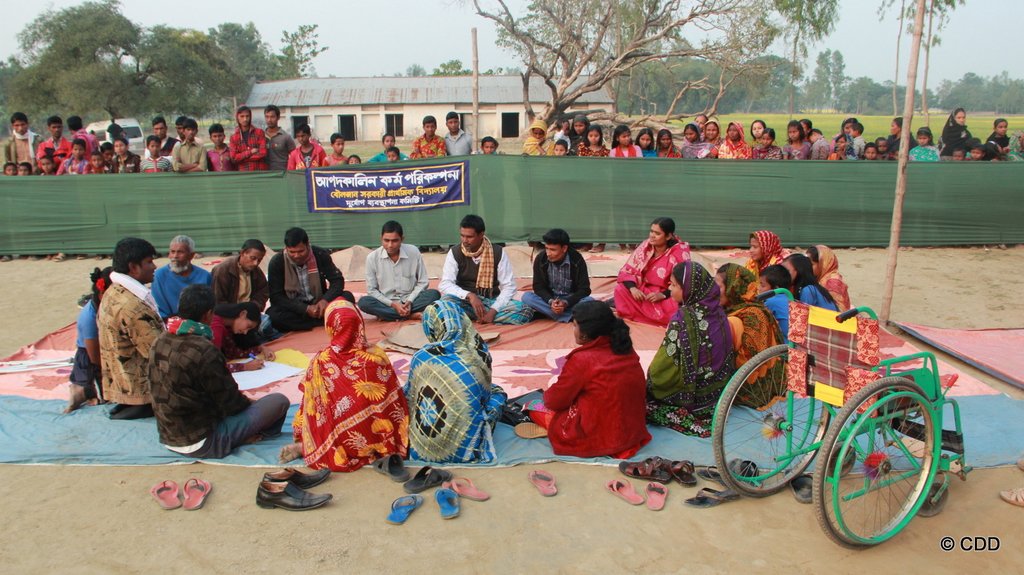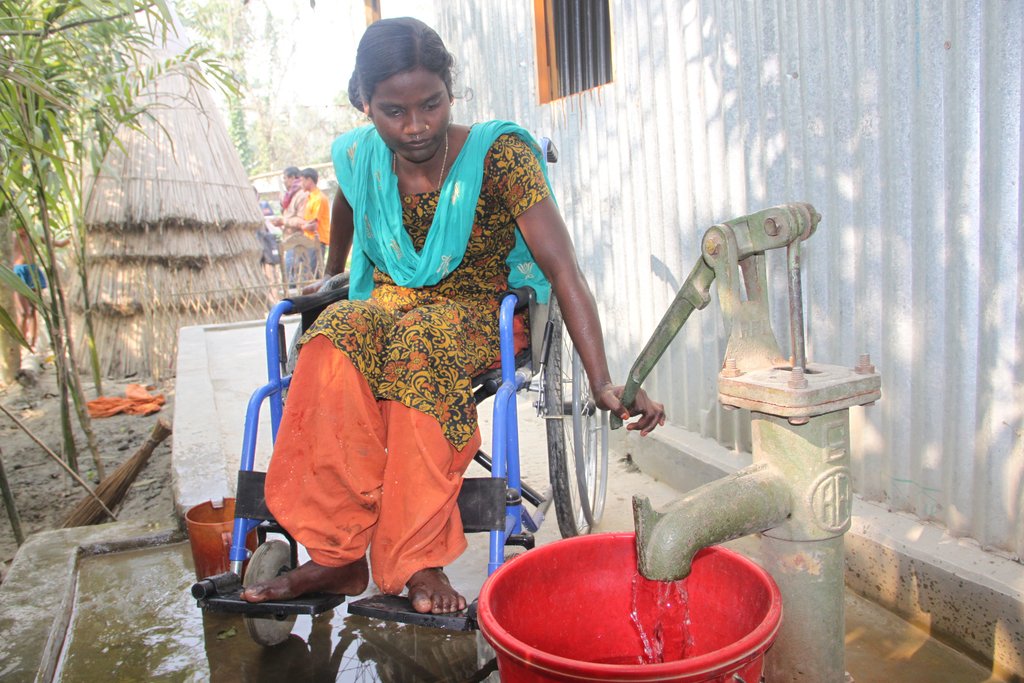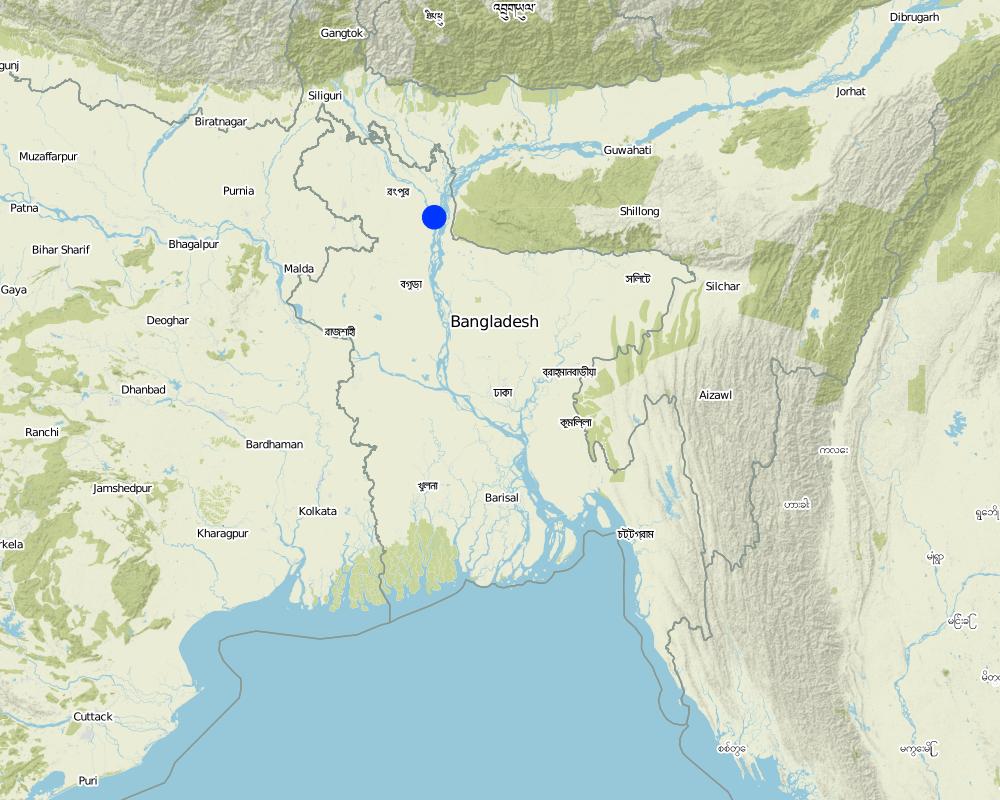Disability inclusive Disaster Risk Reduction [ប្រទេសបង់ក្លាដែស]
- ការបង្កើត៖
- បច្ចុប្បន្នភាព
- អ្នកចងក្រង៖ Subir Saha
- អ្នកកែសម្រួល៖ Subir Saha, Manuel Rothe
- អ្នកត្រួតពិនិត្យ Alexandra Gavilano
Protibondhita Bandhob Durjog Jhuki Rash
approaches_2001 - ប្រទេសបង់ក្លាដែស
ពិនិត្យមើលគ្រប់ផ្នែក
ពង្រីកមើលទាំងអស់ បង្រួមទាំងអស់1. ព័ត៌មានទូទៅ
1.2 ព័ត៌មានលម្អិតពីបុគ្គលសំខាន់ៗ និងស្ថាប័នដែលចូលរួមក្នុងការវាយតម្លៃ និងចងក្រងឯកសារនៃវិធីសាស្ត្រផ្សព្វផ្សាយ
DRR specialist:
Islam Shahidul
+8801733143435
shahidulpls@yahoo.com
Centre for Disability in Development (CDD)
Gaibandha
ប្រទេសបង់ក្លាដែស
DRR specialist:
Dey Ashutosh
880-2-9887251 / +8801787662993
ashutosh.dey@cbm.org
CBM
Country Coordination Office CBM International H # 12 (GF) R # 2/A, Block-F Banani, Dhaka-1213
ប្រទេសបង់ក្លាដែស
DRR Specialist:
ឈ្មោះគម្រោងដែលបានចងក្រងឯកសារ/ វាយតម្លៃលើវិធីសាស្ត្រផ្សព្វផ្សាយ (បើទាក់ទង)
Book project: where people and their land are safer - A Compendium of Good Practices in Disaster Risk Reduction (DRR) (where people and their land are safer)ឈ្មោះអង្គភាពមួយ (ច្រើន) ដែលបានចងក្រងឯកសារ/ វាយតម្លៃលើវិធីសាស្ត្រផ្សព្វផ្សាយ (បើទាក់ទង)
Christoffel Blindenmission (CBM) - ប្រទេសស្វ៊ីស1.3 លក្ខខណ្ឌទាក់ទងទៅនឹងការប្រើប្រាស់ទិន្នន័យដែលបានចងក្រងតាមរយៈវ៉ូខេត
តើពេលណាដែលទិន្នន័យបានចងក្រង (នៅទីវាល)?
09/11/2016
អ្នកចងក្រង និង(បុគ្គលសំខាន់ៗ)យល់ព្រមទទួលយកនូវលក្ខខណ្ឌនានាទាក់ទងទៅនឹងការប្រើប្រាស់ទិន្នន័យដែលបានចងក្រងតាមរយៈ វ៉ូខេត:
បាទ/ចា៎
1.4 ការយោងមួយ (ច្រើន) ទៅលើ (កម្រង) បញ្ជីសំណួរនៃបច្ចេកទេស SLM
2. ការពណ៌នាអំពីវិធីសាស្ត្រផ្សព្វផ្សាយ SLM
2.1 ពណ៌នាសង្ខេបខ្លីពីវិធីសាស្ត្រផ្សព្វផ្សាយ
The disability inclusive approach is centered around the meaningful contribution and leadership of persons with disabilties during the entire project management cycle, from the planning stage to the evaluation of the impact of a project. It contributes to empowering them to overcome social exclusion and recognizes their needs and priorities as persons who are disproportionally at risk of disaster.
2.2 ពណ៌នាលម្អិតពិវិធីសាស្ត្រផ្សព្វផ្សាយ
ពណ៌នាលម្អិតពិវិធីសាស្ត្រផ្សព្វផ្សាយ:
The main charactistic and central feature of the approach is that persons with disabilties can actively and meaningfully participate in, contribute to and benefit from sustainable land management/disaster risk reduction activities. The implementing organization needs to invest sufficient time and financial ressources into the formation and strenthening of self-representation groups of persons with disabilities and support their active engagement with the local government and the wider community to address the physical and attitudinal barriers that hinder their full participation in the project and society in general.
The aim is twofold: On the one hand, the participation of persons with disabitities ensures that their needs and priorities are fully taken into account in the project design and implementation, to ensure that they can benefit equally from it. On the other hand, it contributes to reducing barriers beyond the project and empowers them to demand their rights in other areas of human development, like education, health or livelihood.
The main stages of disability inclusion in the implementation of a SLM/DRR technology are:
1) Formation of self-help groups for persons with disabilities,
2) trainings and other capacity development activities for the groups, including rights awareness sessions and organizational management trainings,
3) set up the collaboration between the groups and the local government and with other members of the community,
4) participation of persons with disabilities/group members in the planning phase to decide on the technology and adapt the technology to universal design standards, which takes into account their needs and the needs of other groups with other specific accessiblity needs, like the elderly or pregnant women,
5) persons with disabilities (together with other land users) support the introduction of the technology (including the construction activities) by providing manual labor and supervision functions
6) full handover of the technology to land users, ensuring Joint ownership includes persons with disabilities, and provision of trainings for self-maintenance,
7) participation of persons with disabilties in the evaluation of the impact of the technology, sharing of lessons and good practices and continuous advocacy for community development and for the rights of persons with disabilties.
Experience from Bangladesh shows that what the land users, including persons with disabilties, like about the approach is: The strong community engagement, the empowerment and increased status of persons with disabilities, the collaboration between persons with disabilities and persons without disability, and the adaptation of existing technology to fit the needs of persons with disability.
2.3 រូបភាពនៃវិធីសាស្ត្រផ្សព្វផ្សាយ
2.5 ប្រទេស/តំបន់/ទីតាំងកន្លែង ដែលវិធីសាស្ត្រផ្សព្វផ្សាយត្រូវបានអនុវត្តន៍
ប្រទេស:
ប្រទេសបង់ក្លាដែស
តំបន់/រដ្ឋ/ខេត្ត:
Gaibandha District
បញ្ជាក់បន្ថែមពីលក្ខណៈនៃទីតាំង:
Horipur Union, Sundargonj Sub district
Map
×2.6 កាលបរិច្ឆេទនៃការចាប់ផ្តើម និងបញ្ចប់នៃវិធីសាស្រ្តផ្សព្វផ្សាយនេះ
សូមបញ្ជាក់ឆ្នាំដែលបានបង្កើតឡើង:
2015
ឆ្នាំបញ្ចប់ (ប្រសិនបើវិធីសាស្ត្រផ្សព្វផ្សាយត្រូវបានឈប់ប្រើប្រាស់):
2016
មតិយោបល់:
Project "Disability inclusive, flood resilient cluster village" implemented from December 2015 to September 2016.
2.7 ប្រភេទនៃវិធីសាស្ត្រផ្សព្វផ្សាយ
- ផ្អែកលើគម្រោង/កម្មវិធី
2.8 គោលបំណង/ទិសដៅសំខាន់នៃវិធីសាស្ត្រផ្សព្វផ្សាយ
To empower persons with disabilities to meaningfully participate in, contribute to and benefit from the implementation of an SLM/DRR technology.
2.9 លក្ខខណ្ឌអនុញ្ញាត ឬរារាំងការអនុវត្តន៍បច្ចេកទេសដែលស្ថិតនៅក្រោមវិធីសាស្រ្តផ្សព្វផ្សាយ
សង្គម/វប្បធម៌/ និងតម្លៃនៃសាសនា
- រារាំង
The social stigma and exclusion, that persons with disabilities experience in rural Bangladesh, was a challenge for the project. Persons with disabilities are sometimes believed to be incapable of contributing anything meaningful to society and village life. Some community members did not want to associate with persons with disabilities. This required an extra effort to ensure the participation of the wider community in the project and it required sustained advocacy and awareness raising for the rights and dignity of persons with disabilities.
ភាពអាចរកបាននៃធនធានហិរញ្ញវត្ថុ និងសេវាកម្ម
- អំណោយផល
The financial resources for the implementation of the technology and the extra ressources needed to ensure disability inclusion, were readily available because the technology was widely and positively recognized by the community and by donors.
បរិបទនៃស្ថាប័ន
- អំណោយផល
The institutional environment was overwhelmingly supportive of the implementation of the project. The local Union Council government, schools, mosques and other civil society organizations were in favor of the technology and approach and supported the implementation.
ការសហការ/ការសម្របសម្រួលតួអង្គពាក់ព័ន្ធ
- អំណោយផល
Beneficiaries/land users were selected in a participative process, involving the whole community. The process was transparent and inclusive. It was a foundation for the smooth collaboration with beneficiaries and other involved stakeholders later on.
ក្របខណ្ឌច្បាប់ (សិទ្ធិកាន់កាប់ដីធ្លី កម្មសិទ្ធីប្រើប្រាស់ដីនិងទឹក)
- អំណោយផល
To ensure joint ownership of beneficiaries of the land on which the SLM/DRR Technology was implemented, an exchange of land was needed. Due to the remoteness and scarce population of the implementation area in rural Bangladesh, a cooperative local government and a manageable legal framework this was easy to achieve.
A deep-rooted tube well was installed for water access of the land users. Water use rights were also easy to acquire.
គោលនយោបាយ
- អំណោយផល
No specific policies existed, which significantly affected the implementation of the technology.
អភិបាលកិច្ចដី (ការសម្រេចចិត្ត ការអនុវត្ត និងការរឹតបន្តឹង)
- អំណោយផល
Land ownership was recognized by the local government and land governance was controlled by land owners.
ចំណេះដឹងស្តីពី SLM និងការទទួលបានការគាំទ្រផ្នែកបច្ចេកទេស
- អំណោយផល
Indigenous knowledge about SLM was enabling for the implementation of the technology. Technical expertise by the implementing organization (NGO) was available.
ទីផ្សារ (ទិញធាតុចូល លក់ផលិតផល) និងតម្លៃ
- អំណោយផល
Inputs for construction and planting were locally available at reasonable prices.
ទំហំការងារ ភាពអាចរកបាននៃកម្លាំងពលកម្ម
- អំណោយផល
During the lean season manpower was abundant in the area, but it was scarce during the planting season. The workload for the implementation of the technology was manageable and could easily be provided by land users themselves.
3. ការចូលរួម និងតួនាទីរបស់ភាគីពាក់ព័ន្ធ
3.1 អ្នកពាក់ព័ន្ធដែលបានចូលរួមក្នុងវិធីសាស្ត្រផ្សព្វផ្សាយ និងតួនាទីរបស់ពួកគេ
- អ្នកប្រើប្រាស់ដីក្នុងតំបន់/សហគមន៍
The land users include 10 families who jointly own and inhabit the land of the cluster village.
Land users were closely engaged in the implementation of the technology by participating in decision making processes, informing the design of the technology and contributing to the construction process.
- អង្គការសហគមន៍មូលដ្ឋាន
Self-help (self-representation) groups of persons with disabilities are informal community based groups of 15 persons with different types of disabilities (physical-, sensory- and mental disabilities).
The group is closely engaged in the implementation of the technology. It participates in decision making processes, informs the design of the technology, contributes to the construction process, is engaged in the evaluation of the technology and the sharing of learnings about it to the wider community.
The group also provides benefits for its members by supporting them with everyday challenges, which can be of economic, legal or social nature, and promotes the rights of all persons with disabilities in the community.
- អង្គការក្រៅរដ្ឋាភិបាល
The implementing NGOs included an international and a local organization in partnership (CBM and CDD).
CDD was responsible for the overall management of project implementation and the collaboration with other involved local stakeholders. CBM provided training and technical support.
- រដ្ឋាភិបាលថ្នាក់មូលដ្ឋាន
The Union Parishad government is the lowest level of local government.
The Union Parishad government managed land ownership and approved construction projects.
3.2 ការចូលរួមរបស់អ្នកប្រើប្រាស់ដីក្នុងតំបន់/ សហគមន៍ក្នុងតំបន់ក្នុងដំណាក់កាលផ្សេងគ្នានៃវិធីសាស្រ្តផ្សព្វផ្សាយ
| ការចូលរួមរបស់អ្នកប្រើប្រាស់ដីក្នុងតំបន់/សហគមន៍ក្នុងតំបន់ | សូមបញ្ជាក់នរណាត្រូវបានចូលរួម ព្រមទាំងពណ៌នាសកម្មភាពទាំងនោះ | |
|---|---|---|
| ការចាប់ផ្តើម/ការលើកទឹកចិត្ត | អន្តរកម្ម | Land users contributed to the initial situation analysis and joined self-help groups for persons with disabilities. |
| ការរៀបចំផែនការ | អន្តរកម្ម | Land users, and in particular those who are persons with disabilities, participated in all planning and decision making processes related to the design and introduction of the technology, including the selection of the land. |
| ការអនុវត្តន៍ | ការគាំទ្រពីខាងក្រៅ | Land users engaged in the construction of the technology by providing paid and unpaid labor. |
| ការត្រួតពិនិត្យ និងវាយតម្លៃ | អន្តរកម្ម | The land users monitored the implementation process and gave feedback to the implementing NGOs when changes were needed. Land users participated in the evaluation of the technology and the approach and contributed to the dissemination of good practices and learnings. |
3.3 គំនូសបំព្រួញ (ប្រសិនបើមាន)
ការពណ៌នា:
Not available.
3.4 ការសម្រេចចិត្តលើការជ្រើសរើសបច្ចេកទេស SLM
សូមបញ្ជាក់តើអ្នកណាជាអ្នកបានសម្រេចចិត្តក្នុងការជ្រើសរើសបច្ចេកទេសដើម្បីយកមកអនុវត្តន៍:
- គ្រប់ភាគីពាក់ព័ន្ធទាំងអស់ដែលជាផ្នែកនៃវិធីសាស្រ្តផ្សព្វផ្សាយដោយមានការចូលរួម
ចូរពន្យល់:
The cluster village technology was known to the community before the implementation. The technology was suggested by the implementing NGOs to the community, which supported its implementation. The technology was adapted to fit the needs of persons with disabilities based on the decisions of land users with technical support of the implementing NGOs.
សូមបញ្ជាក់ តើការសម្រេចធ្វើឡើងដោយផ្អែកលើអ្វីជាមូលដ្ឋាន:
- វាយតម្លៃទៅលើចំណេះដឹងស្តីអំពី SLM ដែលបានចងក្រងជាឯកសារបានត្រឹមត្រូវ (ផ្អែកលើភស្តុតាងជាមូលដ្ឋានដើម្បីសម្រេចចិត្ត)
4. ជំនួយបច្ចេកទេស ការកសាងសមត្ថភាព និងការគ្រប់គ្រងចំណេះដឹង
4.1 ការកសាងសមត្ថភាព/ បណ្តុះបណ្តាល
តើវគ្គបណ្តុះបណ្តាលបានផ្តល់ឱ្យអ្នកប្រើប្រាស់ដី/អ្នកពាក់ព័ន្ធផ្សេងៗទៀតដែរឬទេ?
បាទ/ចា៎
សូមបញ្ជាក់តើអ្នកណាត្រូវបានបណ្តុះបណ្តាល:
- អ្នកប្រើប្រាស់ដី
- បុគ្គលិកចុះទីវាល/អ្នកផ្តល់ប្រឹក្សាយោបល់
ប្រសិនទាក់ទង សូមបញ្ជាក់ ភេទ អាយុ ស្ថានភាពគ្រួសារ ជនជាតិដើមភាគតិច។ល។:
10 males and 15 females, aged between 18 to 55. Three were persons with disabilities. Most of them were daily laborers and share croppers.
ទម្រង់នៃការបណ្តុះបណ្តាល:
- អនុវត្តន៍ជាមួយការងារ
- ទីតាំងបង្ហាញ
- វគ្គបណ្តុះបណ្តាល
ប្រធានបទបណ្តុះបណ្តាល:
On the job training and demonstration on the construction and maintenance of the technology. Training to self-help groups for persons with disabilities on the rights of persons with disabilities, the use and benefits of the technology for persons with disabilities and the management of self-help groups.
មតិយោបល់:
Training Subjects were: 1) Group dynamics and Development, 2) Disability inclusive DRR 3) Tree plantation and Vegetable Gardening using organic fertilizer 4) Government safety nets and Rights of the persons with disabilities.
4.2 សេវាផ្តល់ប្រឹក្សាយោបល់
តើអ្នកប្រើប្រាស់ដីបានទទួលនូវសេវាផ្តល់ប្រឹក្សាដែរ ឬទេ?
បាទ/ចា៎
សូមបញ្ជាក់ប្រសិនបើសេវាកម្មប្រឹក្សាយោបល់ត្រូវបានផ្តល់ឱ្យ:
- នៅលើដីរបស់អ្នកប្រើប្រាស់ដី
- construction/implementation of technology
ពណ៌នា/ពន្យល់:
The implementing NGOs provided detailed technical support to land users on the adaptation of the technology to the needs of persons with disabilities, following the standards of universal design.
4.3 ការពង្រឹងសមត្ថភាពស្ថាប័ន (ការអភិរឌ្ឍន៍អង្គភាព)
តើស្ថាប័នទាំងអស់ត្រូវបានបង្កើតឡើង ឬពង្រឹងសមត្ថភាពតាមរយៈវិធីសាស្ត្រផ្សព្វផ្សាយដែរ ឬទេ?
- បាទ/ច៎ា ជាមធ្យម
សូមបញ្ជាក់ថាតើស្ថាប័នត្រូវបានពង្រឹង ឬបង្កើតឡើងនៅត្រឹមកម្រិតណា(ច្រើន)?
- ថ្នាក់មូលដ្ឋាន
ចូពណ៌នាពីស្ថាប័ន តួនាទី និងទំនួលខុសត្រូវ សមាជិក ។ល។:
Local self-help groups and their APEX body (umbrella group) at Union level were strengthened. Their roles of the self-help groups were to establish a mutual support network, raise awareness among group members of disability rights and development issues, pool ressources and give individual persons with disabilities a greater political voice. The APEX body gave the groups contact points beyond their immediate community and gave further weight to their political voice.
សូមបញ្ជាក់ប្រភេទនៃការគាំទ្រ:
- ហិរញ្ញវត្ថុ
- ការកសាងសមត្ថភាព/ បណ្តុះបណ្តាល
- សម្ភារៈ
សូមផ្តល់ព័ត៌មានបន្ថែមទៀតឱ្យបានលម្អិត:
To strengthen self-help groups, they were provided with, 1) awarness- and skill development trainings, 2) financial support for climate resilient income generation through agricultural and non-agricultural activities, and 3) assistive devices.
4.4 ការត្រួតពិនិត្យ និងវាយតម្លៃ
តើការត្រួតពិនិត្យ និងវាយតម្លៃគឺជាផ្នែកមួយនៃវិធីសាស្ត្រដែរឬទេ?
បាទ/ចា៎
មតិយោបល់:
A participatory monitoring and evaluation system was implemented with support of the self-help groups for persons with disabilties.
ប្រសិន បាទ/ច៎ា តើឯកសារនេះបានបង្កើតឡើងក្នុងគោលបំណងប្រើប្រាស់សម្រាប់ការត្រួតពិនិត្យ និងវាយតម្លៃដែរឬទេ?
ទេ
4.5 ការស្រាវជ្រាវ
តើការស្រាវជ្រាវ គឺជាផ្នែកមួយនៃវិធីសាស្រ្តដែរឬទេ?
ទេ
5. ថវិកា និងសម្ភារៈឧបត្ថម្ភពីខាងក្រៅ
5.1 ថវិកាប្រចាំឆ្នាំសម្រាប់ផ្សព្វផ្សាយ SLM
ចង្អុលបង្ហាញថវិកាប្រចាំឆ្នាំសម្រាប់ផ្នែករបស់វិធីសាស្ត្រផ្សព្វផ្សាយទាក់ទងទៅនឹង SLM - រូមបញ្ចូល៖ វគ្គបណ្តុះបណ្តាល និងការផ្សព្វផ្សាយ ការស្រាវជ្រាវ ការអនុវត្តន៍បច្ចេកទេស - គិតជាដុល្លារ US$:
218702,00
ប្រសិនបើចំនួនពិតប្រាកដនៃថវិកាប្រចាំឆ្នាំមិនត្រូវបានដឹងច្បាស់ សូមប្រាប់ពីចន្លោះនៃថវិកានោះ:
- 100,000-1,000,000
មតិយោបល់ (ឧ. ប្រភពសំខាន់នៃមូលនិធិ/ម្ចាស់ជំនួយចំបង):
The annual budget includes the total funds used for the introduction of the technology. Funds were provided through the implementing NGOs CBM and CDD, with the support of a private donor from Germany.
5.2 ការគាំទ្រផ្នែកហិរញ្ញវត្ថុ / សម្ភារៈដែលបានផ្តល់ទៅឱ្យអ្នកប្រើប្រាស់ដី
តើអ្នកប្រើប្រាស់ដីបានទទួលការគាំទ្រផ្នែកហិរញ្ញវត្ថ/សម្ភារៈសម្រាប់ការអនុវត្តន៍បច្ចេកទេសដែរឬទេ:
បាទ/ចា៎
ប្រសិនបាទ/ច៎ា សូមបញ្ជាក់ប្រភេទ(ច្រើន)នៃការគាំទ្រ លក្ខខណ្ឌ និងអ្នកផ្តល់ឱ្យ(ច្រើន):
Land users received a daily fee for the labor provided for the introduction of the technology. The NGOs also provided most material input for the technology, including soil, sand, seeds, seedlings, grass, trees, ramp, water and sanitation facilties.
5.3 សូមបញ្ជាក់ពីធាតុចូលត្រូវបានផ្តល់បដិភាគ (រួមទាំងកម្លាំងពលកម្ម)
- កម្លាំងពលកម្ម
| កម្រិតទំហំប៉ុណ្ណា | សូមបញ្ជាក់ពីការបដិភាគ |
|---|---|
| ផ្តល់ហិរញ្ញវត្ថុមួយផ្នែក | Labor provided by land users for certain construction actvities was compensated with a daily fee. |
- សម្ភារៈ
| សូមបញ្ជាក់ ធាតុចូលណាខ្លះដែលបានផ្តល់បដិភាគ | កម្រិតទំហំប៉ុណ្ណា | សូមបញ្ជាក់ពីការបដិភាគ |
|---|---|---|
| ម៉ាស៊ីន | ផ្តល់ហិរញ្ញវត្ថុទាំងស្រុង | Rent of sand extravation machine was funded by the project. |
| ឧបករណ៍ | ផ្តល់ហិរញ្ញវត្ថុទាំងស្រុង | Tools for construction activities was provided to land users by the project. |
- កសិកម្ម
| សូមបញ្ជាក់ ធាតុចូលណាខ្លះដែលបានផ្តល់បដិភាគ | កម្រិតទំហំប៉ុណ្ណា | សូមបញ្ជាក់ពីការបដិភាគ |
|---|---|---|
| គ្រាប់ពូជ | ផ្តល់ហិរញ្ញវត្ថុទាំងស្រុង | Seeds and seedlings for the homestead garden was provided by the project. |
| ជី | ផ្តល់ហិរញ្ញវត្ថុមួយផ្នែក | The facility for composting organic fertilizer was provided by the project. |
| Plants | ផ្តល់ហិរញ្ញវត្ថុទាំងស្រុង | Deep-rooted fruit trees and grass turfing was provided by the project. |
- ការសាងសង
| សូមបញ្ជាក់ ធាតុចូលណាខ្លះដែលបានផ្តល់បដិភាគ | កម្រិតទំហំប៉ុណ្ណា | សូមបញ្ជាក់ពីការបដិភាគ |
|---|---|---|
| ឈើ | ផ្តល់ហិរញ្ញវត្ថុមួយផ្នែក | Wood for fencing for the homestead vegetable garden in front of all houses and a flood resilient cow sheds in the village was provided by the project. |
| Soil | ផ្តល់ហិរញ្ញវត្ថុទាំងស្រុង | The purchase of soil for the raising of land was funded by the project. |
- ហេដ្ឋារចនាសម្ព័ន្ធ
| សូមបញ្ជាក់ ធាតុចូលណាខ្លះដែលបានផ្តល់បដិភាគ | កម្រិតទំហំប៉ុណ្ណា | សូមបញ្ជាក់ពីការបដិភាគ |
|---|---|---|
| ផ្លូវ | ផ្តល់ហិរញ្ញវត្ថុមួយផ្នែក | Construction material for barrier free connections to all houses in the village was funded by the project. |
| Ramp | ផ្តល់ហិរញ្ញវត្ថុទាំងស្រុង | A ramp, connecting the cluster village with the road was funded by the project. |
ប្រសិនបើកម្លាំងពលកម្មធ្វើដោយអ្នកប្រើប្រាស់ដី តើវាជាធាតុចូលដ៏សំខាន់មួយដែរ ឬទេ:
- បង់ជាសាច់ប្រាក់
មតិយោបល់:
A daily fee of 300 Taka was provided for labor inputs by the land users.
5.4 ឥណទាន
តើឥណទានដែលបានផ្តល់នៅក្រោមវិធីសាស្ត្រផ្សព្វផ្សាយសម្រាប់សកម្មភាព SLM នេះយ៉ាងដូចម្តេច?
ទេ
5.5 ការលើកទឹកចិត្ត ឬវិធីសាស្ត្រដ៏ទៃទៀត
តើមានការលើកទឹកចិត្តផ្សេងទៀត ឬឧបករណ៍ប្រើប្រាស់ដើម្បីលើកកម្ពស់ការអនុវត្តន៍បច្ចេកទេស SLM?
ទេ
6. ការវិភាគរកផលប៉ះពាល់ និងសេចក្តីសន្និដ្ឋាន
6.1 ផលប៉ះពាល់នៃវិធីសាស្ត្រផ្សព្វផ្សាយ
តើវិធីសាស្ត្រផ្សព្វផ្សាយបានផ្តល់សិទ្ធិអំណាចដល់អ្នកប្រើប្រាស់ដី ធ្វើឱ្យប្រសើរឡើងនូវការចួលរួមអ្នកពាក់ព័ន្ធ?
- ទេ
- បាទ/ច៎ា បន្តិចបន្តួច
- បាទ/ច៎ា ជាមធ្យម
- បាទ/ច៎ា បានខ្លាំង
The approach is based on the empowerment of land users, in particularly those who are persons with disabilites. It ensured participation of persons with disablities who would otherwise be isolated and excluded.
តើវិធីសាស្រ្តផ្សព្វផ្សាយនេះអនុញ្ញាតឱ្យធ្វើការសម្រេចចិត្ដដោយផ្អែកលើភស្តុតាងជាមូលដ្ឋានដែរ ឬទេ?
- ទេ
- បាទ/ច៎ា បន្តិចបន្តួច
- បាទ/ច៎ា ជាមធ្យម
- បាទ/ច៎ា បានខ្លាំង
តើវិធីសាស្ត្រផ្សព្វផ្សាយជួយអ្នកប្រើប្រាស់ដីដើម្បីអនុវត្តន៍ និងថែទាំបច្ចេកទេស SLM?
- ទេ
- បាទ/ច៎ា បន្តិចបន្តួច
- បាទ/ច៎ា ជាមធ្យម
- បាទ/ច៎ា បានខ្លាំង
The project supported land users with the implementation and use of the technology.
តើវិធីសាស្រ្តផ្សព្វផ្សាយនេះធ្វើឱ្យប្រសើរឡើងនូវការសម្របសម្រួលនិងការអនុវត្តចំណាយរបស់ SLMមានប្រសិទ្ធិភាពបែបណា? :
- ទេ
- បាទ/ច៎ា បន្តិចបន្តួច
- បាទ/ច៎ា ជាមធ្យម
- បាទ/ច៎ា បានខ្លាំង
The coordination among land users has improved and actions of land management have become more cost effective.
តើវិធីសាស្រ្តផ្សព្វផ្សាយនេះប្រមូលផ្តុំ / ធ្វើឱ្យប្រសើរឡើងនូវការទទួលបានធនធានហិរញ្ញវត្ថុសម្រាប់ការអនុវត្ត SLM?
- ទេ
- បាទ/ច៎ា បន្តិចបន្តួច
- បាទ/ច៎ា ជាមធ្យម
- បាទ/ច៎ា បានខ្លាំង
តើវិធីសាស្ត្រផ្សព្វផ្សាយនេះធ្វើឱ្យចំណេះដឹងប្រសើឡើង និងសមត្ថភាពរបស់អ្នកប្រើប្រាស់ដីក្នុងការអនុវត្តន៏ SLM?
- ទេ
- បាទ/ច៎ា បន្តិចបន្តួច
- បាទ/ច៎ា ជាមធ្យម
- បាទ/ច៎ា បានខ្លាំង
Land users were provided with trainings and demonstrations about the implementation and use of the technology.
តើវីធីសាស្ត្រផ្សព្វផ្សាយនេះពង្រឹងចំណេះដឹង និងកសាងសមត្ថភាពរបស់អ្នកពាក់ព័ន្ធឬទេ?
- ទេ
- បាទ/ច៎ា បន្តិចបន្តួច
- បាទ/ច៎ា ជាមធ្យម
- បាទ/ច៎ា បានខ្លាំង
The local goverment, other members of the community and other non-governmental organizations took note of the technology and sensitization about the rights and needs of persons with disabilties increased.
តើវីធីសាស្ត្រនេះបានជួយកសាង/ពង្រឹងស្ថាប័ន កិច្ចសហប្រតិបត្តិការរវាងអ្នកពាក់ព័ន្ធដែរ ឬទេ?
- ទេ
- បាទ/ច៎ា បន្តិចបន្តួច
- បាទ/ច៎ា ជាមធ្យម
- បាទ/ច៎ា បានខ្លាំង
The approach strengthened the collaboration between the local government and self-help groups of persons with disabilities.
តើវីធីសាស្ត្រផ្សព្វផ្សាយនេះបានកាត់បន្ថយជំលោះឬទេ?
- ទេ
- បាទ/ច៎ា បន្តិចបន្តួច
- បាទ/ច៎ា ជាមធ្យម
- បាទ/ច៎ា បានខ្លាំង
Joint decision making and the resolution of conflicts among land users improved through the joint managment of the land.
តើវិធីសាស្ត្រផ្សព្វផ្សាយនេះផ្តល់សិទ្ធិអំណាចដល់សង្គមនិងសេដ្ឋកិច្ចដែលក្រុមមិនទទួលបានផលប្រយោជន៍?
- ទេ
- បាទ/ច៎ា បន្តិចបន្តួច
- បាទ/ច៎ា ជាមធ្យម
- បាទ/ច៎ា បានខ្លាំង
The approach empowered persons with disabilities and other land users, who all belonged to economically marginalized groups. Their social and economic status greatly improved.
តើវិធីសាស្ត្រផ្សព្វផ្សាយ បានធ្វើឱ្យប្រសើរឡើងសមភាពយេនឌ័រ និងផ្តល់សិទិ្ធអំណាចដល់ស្ត្រី និងក្មេងស្រី?
- ទេ
- បាទ/ច៎ា បន្តិចបន្តួច
- បាទ/ច៎ា ជាមធ្យម
- បាទ/ច៎ា បានខ្លាំង
Land user participation in the implementation of the technology always included men and women. Self-help groups for persons with disabilities, which were formed and strengthened by the project, always included around 50% women. Meaningful participation by women in group meetings was promoted by the implementing NGOs.
តើវិធីសាស្ត្រផ្សព្វផ្សាយបានលើកទឹកចិត្តដល់អ្នកប្រើប្រាស់ដីដែលជាយុវជន/ក្មេងជំនាន់ក្រោយឱ្យចូលរួមក្នុង SLM ?
- ទេ
- បាទ/ច៎ា បន្តិចបន្តួច
- បាទ/ច៎ា ជាមធ្យម
- បាទ/ច៎ា បានខ្លាំង
The technology was of of high interest for youth clubs, high school students and other young people in the community and many voiced the intention of replicating it in the future.
តើវិធីសាស្ត្រផ្សព្វផ្សាយបានឱ្យប្រសើរឡើងនូវបញ្ហាកាន់កាប់ដីធ្លី/សិទ្ធិអ្នកប្រើប្រាស់ដែលរារាំងដល់ការអនុវត្ត SLM?
- ទេ
- បាទ/ច៎ា បន្តិចបន្តួច
- បាទ/ច៎ា ជាមធ្យម
- បាទ/ច៎ា បានខ្លាំង
តើវិធីសាស្ត្រផ្សព្វផ្សាយនាំឱ្យប្រសើរឡើងនូវសន្តិសុខស្បៀង/ធ្វើឱ្យប្រសើរឡើងនូវអាហាររូបត្ថម្ភ?
- ទេ
- បាទ/ច៎ា បន្តិចបន្តួច
- បាទ/ច៎ា ជាមធ្យម
- បាទ/ច៎ា បានខ្លាំង
The technology improved food security and nutrition through the introduction of fruit tree plantation and a homestead vegetable garden.
តើវិធីសាស្ត្រផ្សព្វផ្សាយធ្វើឱ្យប្រើសើរឡើងនូវការស្វែងរកទីផ្សារ?
- ទេ
- បាទ/ច៎ា បន្តិចបន្តួច
- បាទ/ច៎ា ជាមធ្យម
- បាទ/ច៎ា បានខ្លាំង
The construction of a ramp for road access allows wheelchair users and other persons with limited mobility to better access local markets.
តើវិធីសាស្ត្រផ្សព្វផ្សាយនេះនាំឱ្យមានភាពប្រសើរឡើងក្នុងការទទួលបានទឹក និងអនាម័យ?
- ទេ
- បាទ/ច៎ា បន្តិចបន្តួច
- បាទ/ច៎ា ជាមធ្យម
- បាទ/ច៎ា បានខ្លាំង
The technology improved water access through the drilling of a deep bore hole water source for common water access and the construction of barrier free household latrines.
តើវិធីសាស្ត្រផ្សព្វផ្សាយនេះនាំឱ្យមានកាប្រើប្រាស់ប្រកបដោយចីរភាព/ប្រភពនៃថាមពលកាន់តែប្រើសើរឡើង?
- ទេ
- បាទ/ច៎ា បន្តិចបន្តួច
- បាទ/ច៎ា ជាមធ្យម
- បាទ/ច៎ា បានខ្លាំង
The technology lead to more sustainable energy use through the provision of household based mini solar systems.
តើវិធីសាស្ត្របានធ្វើឱ្យប្រសើរឡើងនូវការកសាងសមត្ថភាពរបស់អ្នកប្រើប្រាស់ដីដើម្បីបន្សុំាទៅនឹងការប្រែប្រួលអាកាសធាតុ/អាកាសធាតុក្តៅហែង និងកាត់បន្ថាយគ្រោះមហន្តរាយទាក់ទឹងនឹងអាកាសធាតុ?
- ទេ
- បាទ/ច៎ា បន្តិចបន្តួច
- បាទ/ច៎ា ជាមធ្យម
- បាទ/ច៎ា បានខ្លាំង
The technology offers a safe and accessible space for housing, fruit and vegetable cultivation and livestock shelter. It greatly improved the capacity of land users to adapt to the increasing occurence and intensity of monsoon floods.
តើវិធីសាស្ត្រផ្សព្វផ្សាយនេះនាំឱ្យមានការងារ ឱកាសរកប្រាក់ចំណូល?
- ទេ
- បាទ/ច៎ា បន្តិចបន្តួច
- បាទ/ច៎ា ជាមធ្យម
- បាទ/ច៎ា បានខ្លាំង
The technology improved income opportunities through the introduction of a flood resilient fruit tree plantation and homestead vegetable garden. Part of the harvest can be sold on the market.
6.2 ការលើកទឹកចិត្តចម្បងៗរបស់អ្នកប្រើប្រាស់ដីសម្រាប់ការអនុវត្តបច្ចេកទេស SLM
- បង្កើនផលិតកម្ម
Vegetable production and fruit production increased and is more flood resilient.
- ការកាត់បន្ថយការធ្លាក់ចុះគុណភាពដី
Soil erosion and land degradation in the custer village reduced.
- កាត់បន្ថយហានិភ័យនៃគ្រោះមហន្តរាយ
Reduction of disaster risk was the main motivating factor for land users. The cluster village is a flood-resilient safe-place providing shelter for the whole community, including their livestock, during flood season.
- កាត់បន្ថយទំហំការងារ
Household works and household based income generating activities have become easier to organize because of the safety and reliable energy supply that the cluster village provides.
- ការផ្សារភ្ជាប់ទៅនឹងចលនា/គម្រោង/ក្រុម/បណ្តាញ
Joint ownership of the cluster village by land users, who all belonged to an economically marginalized part of the community (daily laborers and share-croppers) and the formation of self-help groups for persons with disabilities, have greatly improved social cohesion among land users.
6.3 សកម្មភាពផ្សព្វផ្សាយដែលប្រកបដោយចីរភាព
តើអ្នកប្រើប្រាស់ដីអាចធ្វើឱ្យមានចីរភាពនូវអ្វីដែលត្រូវបានអនុវត្តន៍តាមរយៈវិធីសាស្ត្រផ្សព្វផ្សាយដែរឬទេ(ដោយពុំមានការគាំទ្រពីអ្នកខាងក្រៅ)?
- មិនប្រាកដ
ប្រសិន ទេ ឬមិនប្រាកដសូមបញ្ជាក់ និងពន្យល់:
The maintenance of the cluster village (including grass turfing, tree plantation, vegetable garden, solar panels, water and sanitation facilities) is currently managed by land users themselves . Long-term sustainability cannot be evaluated yet.
6.4 ភាពខ្លាំង/ គុណសម្បត្តិនៃវិធីសាស្ត្រផ្សព្វផ្សាយ
| ភាពខ្លាំង/ គុណសម្បត្តិ/ ឱកាស ទស្សនៈរបស់អ្នកប្រើប្រាស់ដី |
|---|
| Land users greatly apprechiate the empowerment and social cohesion that the approach enabled. Decisions are taken together and conflicts in the village can be mitigated. The Cluster Village has become a safe space and meeting point for the whole community. |
| The Cluster Village is fully inclusive of persons with disabilities (inclusion in decision making processes and social activities and fully accessible infrastructure), which is something that land users are proud of because it is the first such set-up in the community and is apprechiated as a model by others. |
| ភាពខ្លាំង/ គុណសម្បត្តិ/ ឱកាស ទស្សនៈរបស់បុគ្គលសំខាន់ៗ |
|---|
| Meaningful participation and of persons with disabilities in project implementation has a signaling effect beyond the project and fosters sensitization of the local government and wider community for more inclusive community development and principles of universal design. |
| Formation of self-help groups of persons with disabilities and their active engagement with the wider community on community development issues, which go beyond the rights and needs of persons with disabilites, lead to empowerment and geater social inclusion of persons with disabilities. |
6.5 ភាពខ្សោយ/ គុណវិបត្តិនៃវិធីសាស្ត្រ និងរកដំណោះស្រាយ
| ភាពខ្សោយ/ គុណវិបត្តិ/ ហានិភ័យ ទស្សនៈរបស់អ្នកប្រើប្រាស់ដី | តើបច្ចេកទេសទាំងនោះបានដោះស្រាយបញ្ហាដូចម្តេច? |
|---|---|
| Technical knowledge gap when it comes to the maintenance of the technology and the continuous dependence on external support. | Invest sufficient ressources in trainings and capacity building and emphasis and formalize the transfer of ownership of the technology to land users. |
| ភាពខ្សោយ/ គុណវិបត្តិ/ ហានិភ័យក្នុងទស្សនៈរបស់បុគ្គលសំខាន់ៗ | តើបច្ចេកទេសទាំងនោះបានដោះស្រាយបញ្ហាដូចម្តេច? |
|---|---|
| Formation and strenthening of self-help groups of persons with disabilties to the level where they are sustainable and able to make significant contributions to the projects and community development and demand their rights, takes significant ressources with regard to time and funds invested. | Strong committment of the implementing organization to inclusive programming and sufficient internal capacity building. |
7. ឯកសារយោង និងវេបសាយ
7.1 វិធីសាស្ត្រ/ ប្រភពនៃព័ត៌មាន
- តាមការចុះទីវាល ការស្រាវជ្រាវនៅទីវាល
6
- ការសម្ភាសន៍ជាមួយអ្នកប្រើប្រាស់ដី
10
- ការសម្ភាសន៍ជាមួយអ្នកជំនាញ/ ឯកទេស
2
- ការចងក្រងពីរបាកការណ៍ និងឯកសារផ្សេងៗទៀតដែលមាន
5
7.2 ឯកសារយោងដែលបានចេញផ្សាយ
ចំណងជើង អ្នកនិពន្ធ ឆ្នាំ ISBN:
Disability inclusive disaster risk managment, CBM, 2013
មានប្រភពមកពីណា? ថ្លៃដើមប៉ុន្មាន?
http://www.cbm.org/article/downloads/54741/Disability_Inclusive_Disaster_Risk_Management.pdf
ការតភ្ជាប់ និងម៉ូឌុល
ពង្រីកមើលទាំងអស់ បង្រួមទាំងអស់ការតភ្ជាប់
គ្មានការតភ្ជាប់
ម៉ូឌុល
គ្មានម៉ូឌុល


